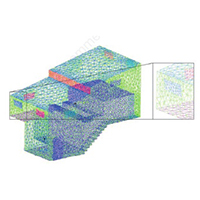Computational fluid dynamics assessment of effect of different openings configurations on the thermal environment of a facility for coffee wet processing

All claims expressed in this article are solely those of the authors and do not necessarily represent those of their affiliated organizations, or those of the publisher, the editors and the reviewers. Any product that may be evaluated in this article or claim that may be made by its manufacturer is not guaranteed or endorsed by the publisher.
Authors
This study aimed to analyze the effect of the area size and location of openings for natural ventilation on the temperature and relative humidity inside a typological facility for coffee wet processing that have been using in Colombia and some South America Countries as well, with mechanical drying inside, using modeling with computational fluid dynamics modeling, in order to find the best suitable condition for preserve the quality of the coffee parchment. A significant effect was found regarding the area and location of the openings for natural ventilation on the internal hygrothermal environment, but no significant effect was found on the temperature. It was also found that the chimney effect plays a decisive role in the mass transfer of water vapor and heat to the outside of the building, and helping to maintain a suitable internal environment for the preservation of coffee.














